Types of Saunas: Which One Is Right for You?
Looking to add a sauna to your home but unsure which type to choose? Whether you're after a traditional experience or modern wellness benefits, this guide breaks down the types of saunas to help you pick the perfect one for your needs.
1. Traditional Wood-Burning Sauna
Best For: Sauna Purists Seeking an Authentic Experience
A traditional wood-burning sauna gives you the classic, rustic sauna experience with the warmth of fire and the scent of burning wood. These saunas can heat up to 195°F, providing an intense, dry heat. They're perfect for those who love the ambiance of crackling wood and the therapeutic benefits that come with it.
Pros
-
🌱 Eco-friendly (if sustainably sourced wood is used)
-
💸 Economical to run once you have the wood
-
🌿 Authentic, rustic experience
Cons
-
❌ No precise temperature control
-
⏳ Longer heating time (45-60 minutes)
-
🔥 Requires regular maintenance (wood, ash cleanup)
2. Electric Sauna
Best For: Practical Users Seeking Efficiency and Flexibility
Electric saunas are a convenient modern alternative. Powered by electricity, they heat up much faster and allow you to easily control the temperature. You can install them both indoors and outdoors, making them perfect for any space.
Pros
-
⚡ Quick heating time (15-20 minutes)
-
🛠️ Easy to install and maintain
-
🧘♂️ Precise temperature control
Cons
-
💡 Higher energy costs
-
🌍 Not ideal for off-grid locations
-
✨ Less rustic ambiance
3. Infrared Sauna
Best For: Modern Users Seeking Comfort and Wellness
Infrared saunas use light rays to directly heat your body, making them perfect for those looking to experience sauna therapy without intense heat. With temperatures ranging from 80°F to 130°F, these saunas are more comfortable and still offer great health benefits.
Pros
-
💪 Direct body heating (fast results)
-
🌡️ Lower temperatures for comfort
-
🧘♀️ Easy to use and maintain
Cons
-
🏠 Smaller than traditional saunas
-
🎭 Lacks authentic sauna ambiance
-
💰 Expensive with upgrades
4. Hybrid Sauna (Infrared + Electric)
Best For: Users Seeking the Best of Both Worlds
Hybrid saunas combine both infrared and electric heating methods. This allows you to enjoy the benefits of both infrared therapy (like detoxification) and the faster heating of electric saunas. These saunas are flexible, offering a customizable experience based on your needs.
Pros
-
🌟 Dual benefits of infrared therapy and electric heating
-
⚡ Quick heating time (electric) with the added benefits of infrared light
-
🛠️ Customizable sauna experience for different needs (e.g., detox vs. muscle relief)
Cons
-
💸 Higher initial cost due to dual heating elements
-
🌍 Requires a suitable space for installation (larger footprint)
-
🔧 More complex setup and maintenance
Which Type of Sauna Is Best for You?
Choosing the right sauna comes down to your space, budget, and health goals. Here's a quick guide:
-
Traditional Sauna: Ideal for those seeking an immersive, authentic experience with high heat and a rustic vibe.
-
Electric Sauna: Perfect for anyone looking for efficiency, ease of use, and precise temperature control.
-
Infrared Sauna: Best for users who want a lower heat option but still enjoy significant health benefits like detoxification and muscle relaxation.
-
Hybrid Sauna: Ideal for those who want the flexibility to enjoy both infrared therapy and faster electric heating in one sauna.
Sauna Comparison Chart
Sauna Type
Heating Method
Ideal For
Heating Time
Maintenance
Temperature Range
Traditional (Wood-burning)
Wood and stones
Authentic, traditional sauna experience
Long (45-60 mins)
High (cleaning ash)
170-195°F
Electric
Electricity and stones
Easy, indoor or outdoor, precise control
Short (15-20 mins)
Low (minimal)
150-190°F
Infrared
Infrared light
Comfort and wellness, lower heat levels
Short (immediate)
Low (minimal)
80-130°F
Hybrid
Infrared + Electric
Customizable experience for various needs
Short (15-20 mins)
Medium (dual systems)
80-195°F
FAQs About Different Types of Saunas
Each type of sauna offers unique health benefits. Traditional saunas are known for providing a more immersive experience, while infrared saunas are great for targeted benefits like skin rejuvenation and detoxification.
Electric and infrared saunas are great for indoor use. They're easy to install and require minimal maintenance, making them ideal for home wellness.
Dry saunas, like infrared and traditional wood, offer intense heat exposure, which many users prefer. Wet saunas, also known as steam rooms or steam showers, are great for respiratory health but may feel cooler and don’t deliver all of the heat benefits.
Yes, there are compact saunas available, such as 1- or 2-person electric or infrared saunas, which are perfect for small spaces. These saunas can fit in bedrooms, bathrooms, or small corners of a home, making them an ideal option for those with limited room.
The cost to run a sauna depends on the type. Electric and infrared saunas tend to have lower operating costs compared to wood-burning saunas, which require purchasing and storing wood. Infrared saunas are more energy-efficient, often consuming less power than traditional electric saunas.
A well-maintained sauna can last for many years. Traditional saunas typically have a lifespan of 10-15 years, while infrared and electric saunas can last 15-20 years with proper care. Regular cleaning and maintenance will ensure that your sauna operates efficiently for years to come.

Installation Considerations for Your Sauna
When it comes to adding a sauna to your home, it’s important to consider where you’ll install it. Here are a few key points to think about:
-
Indoor vs. Outdoor:
-
Indoor: Electric and infrared saunas are great for indoor use, especially if you have limited outdoor space.
-
Outdoor: Traditional wood-burning saunas often require an outdoor setting due to the smoke emission. Electric and infrared saunas can also be used outdoors if you have the right space.
-
-
Space Requirements:
-
Make sure to measure the area where you plan to install the sauna. Traditional saunas typically require more space, while infrared and electric saunas are more compact and can fit into smaller areas.
-
-
Electrical Setup:
-
Electric saunas will require a dedicated electrical circuit. The majority of infrared saunas are plug-and-play, but a few will also need special power outlets, so be sure to check the manufacturer’s installation guidelines.
-
-
Plumbing and Ventilation:
-
Most saunas don’t require plumbing, but if you plan on using your sauna outdoors, ensure there’s proper drainage and ventilation to prevent moisture buildup.
-


Maximizing Your Sauna Experience
Here are some tips to make the most of your sauna sessions:
-
Hydrate: Always drink plenty of water before, during, and after your sauna session to avoid dehydration.
-
Timing: For beginners, start with shorter sessions (around 10-15 minutes) and gradually increase as your body gets accustomed to the heat.
-
Use Aromatherapy: Enhance the experience with essential oils. Lavender or eucalyptus oils can add to the relaxation.
-
Stretching and Meditation: Incorporating light stretching or meditation during your session can maximize the health benefits, particularly for muscle recovery and mental clarity.
-
Cool Down: After your sauna session, take a few minutes to cool down and let your body return to normal before jumping back into your routine.
Final Thoughts: Making the Right Choice
When deciding between the various types of saunas, consider your space, goals, and budget. Whether you’re after the classic wood-burning charm or the modern efficiency of an infrared sauna, there’s a sauna type suited to your needs.
Ready to bring sauna therapy to your home? Explore My Sauna World’s collection of high-quality saunas or contact us to find the perfect fit for your wellness routine.
SIGN UP. SAVE BIG.
Subscribe to be the first to know about our special monthly sauna sales, sent right to your inbox.

About the Author
Adam Fromson
Adam Fromson, co-founder of My Sauna World, loves saunas and their transformative health benefits. With years of experience exploring sauna culture and its impact on health and wellness, Adam is passionate about helping others discover the life-changing benefits of saunas for themselves.
Let customers speak for us
from 385 reviews
Good communication, easy delivery, easy set up, easy operation, great value. Recommended!
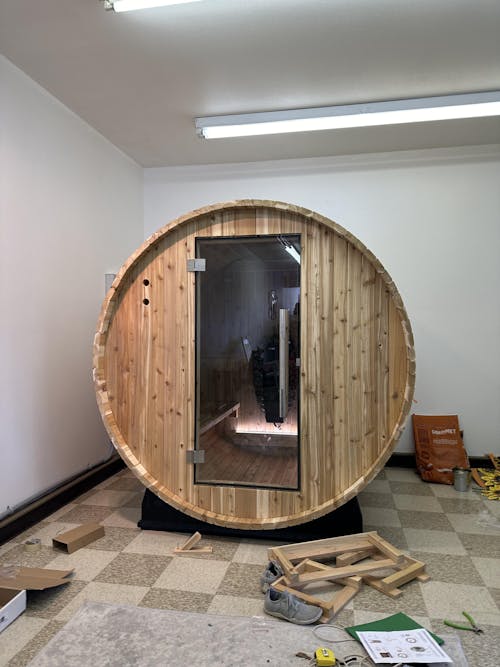
We ordered the 4 person barrel sauna and love it! We wanted a little extra space for the 2 of us/guests and it’s great. We could definitely fit 4 people in it if we needed. We use it every single day. It took about 10 weeks to get here because they build it specifically for the order. Putting the barrel together was fairly easy with 2 people. The electrical and the heater definitely required an electrician to install as we could have not done it alone.
We ordered the biggest heater (harvia spirit 8kw) and it heats up the sauna in about 15 mins inside our 40-50° garage. Overall this style of sauna is hotter and you sweat a lot faster than in an infrared sauna. I truly 10/10 recommend!
Pic is of us in the middle of building it.
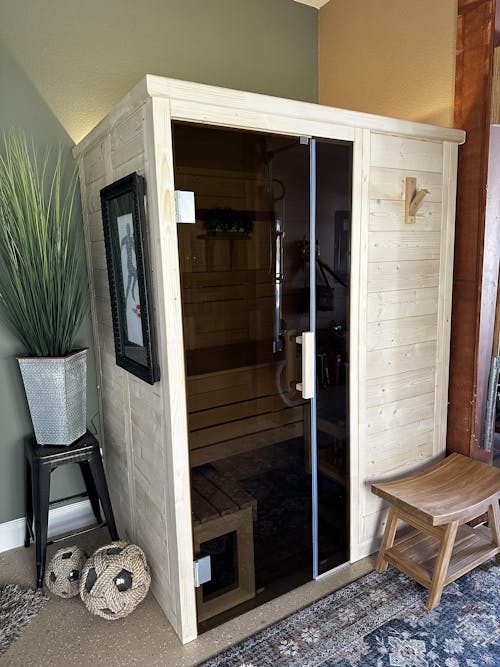
Took me about 6 hours over 2 evenings to assemble almost all by myself. Had a pro run a new circuit from my panel. Very well made and assembly was straightforward. Heater is well sized and reaches operating temperature in under 30 minutes.
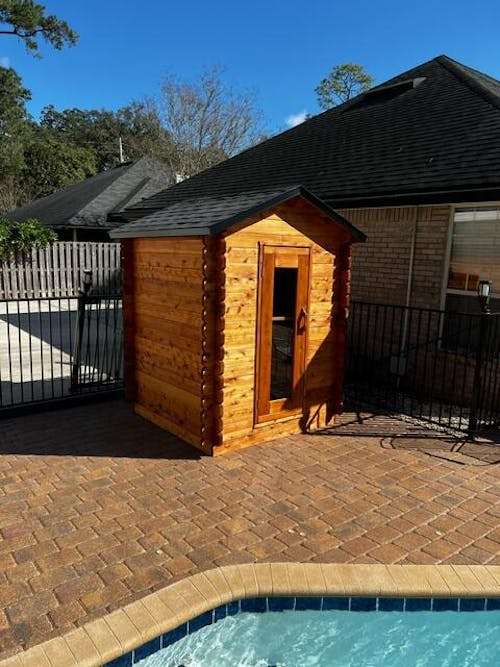
Great sauna very easy to assemble

The salt panel was a great addition to our Madison Sauna. It has excellent grain which is accented by the amazing color lights that glow through the panel. Also when you hit the rocks with a splash of water you can feel the heat bounce off the panel. Great addition if you are considering this option.
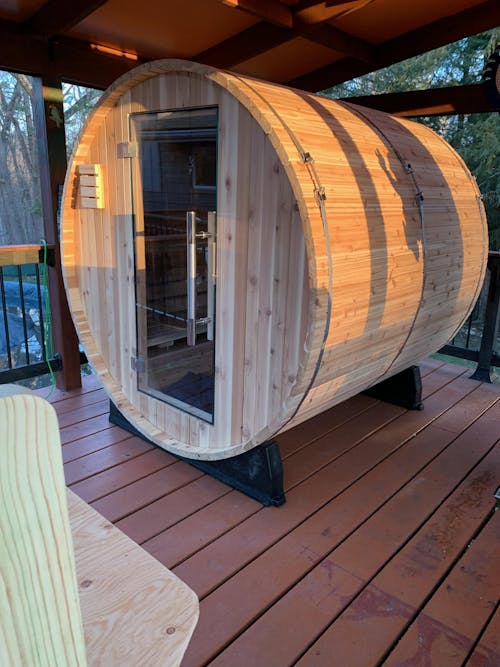
We can say enough about Sauna World there customer support is great! Our Pinnacle Sauna from Almost Heaven is epic.
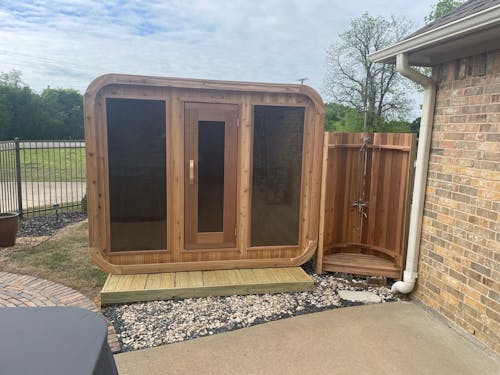
The finish and quality is outstanding and it was quick and easy to assemble.
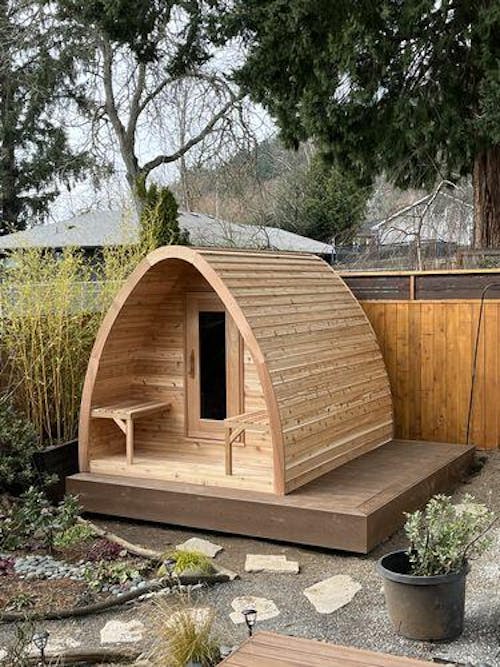
We are thrilled with our mini pod!! It came well shipped and our friend assembled it in 11 hours! Wow! We cannot wait to get healthy and sauna it up!
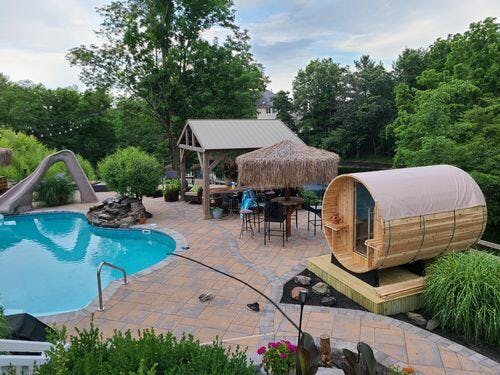
Beautiful sauna!!! Much easier than I expected to assemble, took a total of 4 hours. Can't wait to get warm by the pool on those cool evenings. Customer service was excellent..

Purchased a 2 person Almost Heaven barrel sauna and were delighted with the product. The order process was quick and easy, the sauna arrived on-time, installation was simple, following the provided instructions, and the sauna is extremely high quality. We’ve used it daily for over 2 weeks and quite frankly I don’t know how we lived without it. If I had it to do over again I wouldn’t change a thing... except maybe purchasing a 4 person model to easier share with friends!
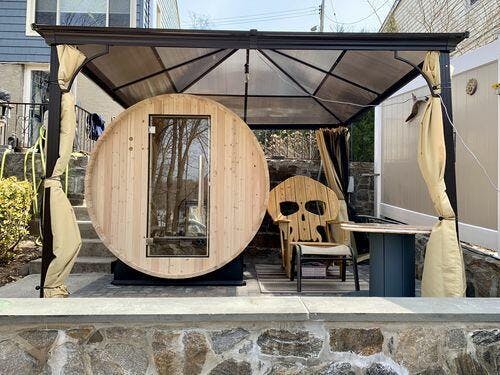
Great Customer Service and a breeze to put together.Excellent shipping and the Sauna is top notch, couldn’t be happier






























